Pethia padamya
Odessa Barb
SynonymsTop ↑
Puntius padamya Kullander & Britz, 2008
Etymology
Pethia: the generic vernacular name for small cyprinids in the Sinhala language.
padamya: padamya is the Burmese word for ‘ruby’, used in reference to the name ‘ruby barb’ used in the ornamental fish trade, and to the bright red color of the males.
Classification
Order: Cypriniformes Family: Cyprinidae
Distribution
Known only from central Myanmar where the type specimens were collected from a man-made pond fed by a small stream in a village called Toe Gyi which lies in the administrative division of Mandalay.
It’s also been recorded from lower stretches of the river Chindwin, a tributary of the Ayeyarwady, and a ‘small pond’ 500m away from the main river channel.
Habitat
The type specimens were collected at an altitude of around 3000m above sea level.
The waters were generally clear, lacking in aquatic plants, and flowing over limestone resulting in a pH value of around 11.0.
Substrates in the area were of gravel or mud (R. Britz, pers. comm.).
Maximum Standard Length
Normally 40 – 45 mm; the largest officially-recorded specimen measured 46.4 mm.
Aquarium SizeTop ↑
Base dimensions of at least 80 ∗ 30 cm or equivalent are required.
Maintenance
Choice of décor is not especially critical though it tends to show better colouration in a heavily-planted set-up with a dark substrate.
The addition of some floating plants and driftwood roots or branches to diffuse the light entering the tank also seems to be appreciated and adds a more natural feel.
Filtration does not need to be particularly strong though it does seem to appreciate a degree of water movement and will also do well in a hill stream-type set-up.
Water Conditions
Temperature: 16 – 25 °C
pH: 6.5 – 8.5
Hardness: 90 – 357 ppm
Diet
Likely to be a foraging omnivore feeding on worms, insects and other small invertebrates, as well as plant material and organic detritus.
In the aquarium it’s easily-fed but the best condition and colours offer regular meals of small live and frozen foods such as bloodworm, Daphnia, and Artemia, alongside good quality dried flakes and granules, at least some of which should include additional plant or algal content.
Behaviour and CompatibilityTop ↑
Generally very peaceful making it an ideal resident of the well-researched community aquarium.
Fishes inhabiting similar biotopes in nature, especially comparably-sized, open water-dwelling cyprinids perhaps constitute the best choices but other potential options include balitorid, cobitid, and nemacheilid loaches as well as benthic cyprinids such as Crossocheilus and Garra species.
Quite a few fishes from the Ayeyarwady basin are available in the trade including Danio choprae, D. albolineatus, D. kyathit, D. tinwini, D. shanensis, Pethia stoliczkana, P. tiantian, P. ticto, Acanthocobitis botia, Schistura vinciguerrae, Lepidocephalichthys berdmorei, and Crossocheilus latius.
As always research your planned combination thoroughly before purchase in order to avoid problems.
Try to buy a mixed-sex group of at least 8-10 specimens, include other schooling fishes to provide security, and you’ll be rewarded with a more natural-looking spectacle.
The interaction between rival males is interesting to watch and they will display their best colours when competing for female attention or hierarchical position.
Sexual Dimorphism
Males possess a thick band of bright red-orange colouration on the flanks and more intensely-defined markings in the fins.
Sexually-mature females are usually thicker-bodied than males and have a much plainer colour pattern.
Reproduction
Like most small cyprinids Pethia spp. are egg-scattering free spawners exhibiting no parental care.
When in good condition they will spawn often and in a mature aquarium it’s possible that small numbers of fry may start to appear without intervention.
However if you want to maximise yield a more controlled approach is required.
The adult group can still be conditioned together but a smaller aquarium should also be set up and filled with mature water.
This should be very dimly lit and the base covered with some kind of mesh of a large enough grade so that the eggs can fall through but small enough so that the adults cannot reach them. The widely available plastic ‘grass’-type matting can also be used and works well, as does a layer of glass marbles.
Alternatively filling much of the tank with a fine-leaved plant such as Taxiphyllum spp. or spawning mops can also return decent results.
The water itself should be of slightly acidic to neutral pH with a temperature towards the upper end of the range suggested above, and an air-powered sponge filter or air stone(s) should also be included to provide oxygenation and water movement.
When the adults are well-conditioned and the females appear gravid one or two pairs should then be introduced, and spawning should take place the following morning.
An alternative is to spawn the fish in a group with half a dozen specimens of each sex being a good number, although a larger aquarium may be necessary.
In either situation the adults will probably eat the eggs given the chance and should be removed as soon as any are noticed.
These should hatch in 24 – 48 hours with the fry free swimming around 24 hours later.
They should be fed on an infusoria-grade food for the first few days until large enough to accept microworm, Artemia nauplii, or suchlike.
NotesTop ↑
This species has been in the aquarium trade since the early 1970s but its precise origin was a mystery until 2003.
It first appeared in Ukraine, the common name ‘Odessa’ being derived from the port city of that name, and when it arrived in western Europe was widely considered a hybrid of similar-looking congeners such as P. conchonius, P. ticto and P. cumingii.
It was also hypothesised as a subspecies of P. ticto or P. conchonius, and some suggested the fish to be artificially dyed.
Following the discovery of natural populations wild-caught specimens began to appear in the hobby and it became clear that the Odessa barb was a species in its own right but confusion continued for a further 5 years until the formal description was published in October 2008.
One interesting fact regarding the wild vs. aquarium strain of P. padamya is that the farm-produced fish seem to hold their colouration better when stressed.
Although this has yet to be verified we suspect that the original captive population of the species has been line-bred for colour over the years resulting in this trait.
In all other aspects both natural and ornamental variants appear identical.
P. padamya was formerly included in the Puntius conchonius ‘group’ of closely-related species alongside P. ater, P. bandula, P. conchonius, P. cumingii, P. didi, P. erythromycter, P. gelius, P. khugae, P. macrogramma, P. manipurensis, P. meingangbii, P. nankyweensis, P. nigripinnis, P. nigrofasciatus, P. phutunio, P. punctatus, P. reval, P. shalynius, P. stoliczkanus, P. thelys, P. tiantian, and P. ticto, but all of these were moved to the new genus Pethia by Pethiyagoda et al. (2012), as were P. melanomaculata, P. pookodensis, P. muvattupuzhaensis, P. ornatus, and P. yuensis.
‘Puntius‘ narayani was not moved to the new genus and is currently of uncertain generic placement since it uniquely possesses 9 branched dorsal-fin rays and 6 branched anal-fin rays.
Pethia species are defined by the following combination of characters: rostral barbels absent; maxillary barbels minute or absent; possession of a stiff, serrated last unbranched dorsal-fin ray; presence of a black blotch on the caudal peduncle, and frequently, black blotches, spots or bars on the side of the body; infraorbital 3 deep and partially overlapping the preoperculum.
P. padamya can be told apart from congeners by the following combination of characters: presence of maxillary barbels; lateral line incomplete with 5-8 pored scales; 12 circumpeduncular scales; in adult males dorsal, anal and pelvic fins hyaline with black margins and 2-3 rows of black spots; humeral marking elongate vertically covering three or more scales; caudal peduncle marking covering parts of 1-2 scales, indistinct in adult males.
It’s most similar to P. didi but can be told apart by the extent of the humeral marking which extends down to the lateral line (vs. reaching pectoral-fin base in P. didi), posession of dark margins and multiple rows of spots in the pelvic and anal fins (vs. lacking dark markings or with blackish marginal stripe and single row of spots across centre), and presence of orange-red flank pigmentation in males (vs. absence).
P. meingangbii and P. manipurensis share a colour pattern in which males possess red pigmentation on the flanks and caudal-fin.
The former is poorly-known but is supposed to lack barbels, have a larger marking on the caudal peduncle, and possess dark-to-reddish pelvic and anal fins, while in P. manipurensis the humeral marking is relatively small, barbels absent, and there are no dark spots in the pelvic and anal fins.
The genus Puntius was viewed as a polyphyletic catch-all containing over 100 species of small to mid-sized cyprinid for a number of years until Pethiyagoda et al. (2012) published a partial review covering South Asian members.
The majority of sub-Himalayan Puntius species were reclassified and new genera Dawkinsia, Dravidia, and Pethia erected to accomodate some of them, with the remainder either retained in Puntius or moved to the existing Systomus assemblage, though the definition of the latter was altered meaning some Southeast Asian species formerly placed there are no longer members.
It subsequently became clear that the name Dravidia was preoccupied by a genus of flesh fly, therefore the replacement name Haludaria was made available by Pethiyagoda (2013).
No species from Indochina, China, or Indonesia were included in the study meaning a significant number of former Puntius are currently classed as incertae sedis, i.e., of uncertain taxonomic placement, and this also applies to a number of South Asian species of unresolved status.
They’re perhaps best referred to as ‘Puntius‘ for the time being whereby the genus name is surrounded by quotation marks to denote its questionable usage, and that is the convention used here on SF at the moment.
References
- Kullander, S. O. and R. Britz, 2008 - Electronic Journal of Ichthyology, Bulletin of the European Ichthyology Society 2: 56-66
Puntius padamya, a new species of Cyprinid fish from Myanmar (Teleostei: Cyprinidae). - Kottelat, M. and H-H Tan, 2011 - Ichthyological Exploration of Freshwaters 22(3): 209-214
Systomus xouthos, a new cyprinid fish from Borneo, and revalidation of Puntius pulcher (Teleostei: Cyprinidae). - Kullander, S. O., 2008 - Ichthyological Exploration of Freshwaters 19(1): 59-84
Five new species of Puntius from Myanmar (Teleostei: Cyprinidae). - Kullander, S. O. and F. Fang, 2005 - Copeia 2005(2): 290-302
Two new species of Puntius from northern Myanmar (Teleostei: Cyprinidae). - Marcus Knight, J. D., K. Rema Devi, T. J. Ingram, and M. Arunachalam, 2012 - Journal of Threatened Taxa 4(3): 2409-2416
A new species of barb Puntius nigripinnis (Teleostei: Cyprinidae) from southern Western Ghats, India. - Pethiyagoda, R., 2013 - Zootaxa 3646(2): 199
Haludaria, a replacement generic name for Dravidia (Teleostei: Cyprinidae). - Pethiyagoda, R., M. Meegaskumbura, and K. Maduwage, 2012 - Ichthyological Exploration of Freshwaters 23(1): 69-95
A synopsis of the South Asian fishes referred to Puntius (Pisces: Cyprinidae).

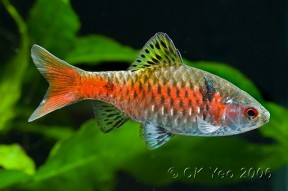
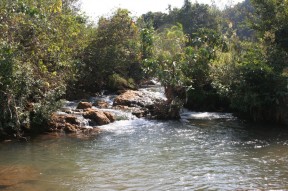

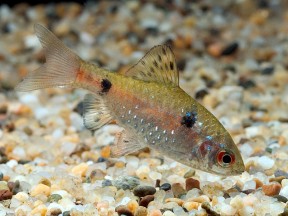

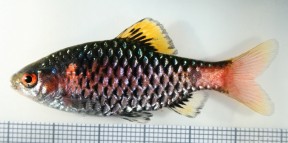
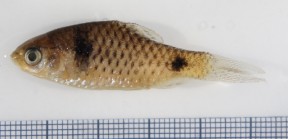
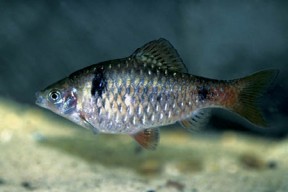

February 3rd, 2018 at 6:06 pm
“The type specimens were collected at an altitude of around 3000m above sea level.”
That’s quite improbable. Either a mistake or the fish up there are able to cope at least a Western European winter. Considering an average of 15*C for Januaru in locations situated at about 1000m asl, like Lake Inle, that are seeing a few near-freezing temperaures during winter, another 2000m would take 10*C from that average, resulting a January like Paris, only having bigger diurnal amplitudea therefore quite hard freezes.
Or, such hardiness is quite improbable. Such elevation also improbable. I would love to have that P. padamya coming from 3000m, since I only have to worry about overheating in our summers :). I found them being less hardy then conchonius, that were able to survive 2*C under 3cm of ice for 2-3 days.
Anyone able to bring some light on this topic?
Thanks!
March 5th, 2018 at 2:50 pm
According to http://www.fishbase.org/summary/64645 the type locality Toe Gyi village is “situated just above the Anisakan Falls, near Pyin Oo Lwin, on the road Mandalay-Hsipaw”. Pyin Oo Lwin lies at 1070 m above sea level (i.e. ~ 3000 feet ASL).
March 9th, 2018 at 11:41 am
“The waters were generally clear, lacking in aquatic plants, and flowing over limestone resulting in a pH value of around 11.0.”
“pH: 6.5 – 8.5”
There is a problem, right?